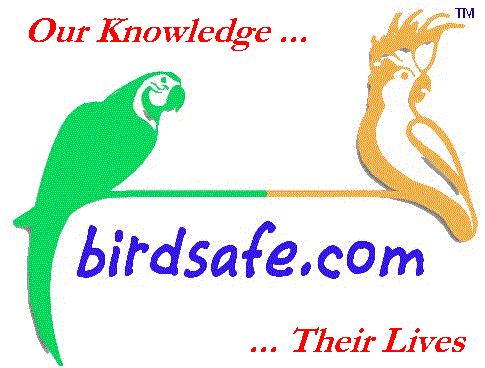


Story Bird: Meggie
The
moon rose high in the spring
evening sky and I was on my way to
bed. Meggie, my ten month old Congo
African Grey, had long since
settled down to sleep, softly
grinding her beak, her neck
feathers fluffed, her foot tucked
under her belly, no doubt toasty
warm. As late as it was, I
could not resist the impulse to
open her cage door quietly and lean
down to her. In a soft voice,
Meggie whispered,
"Kiss?" Gladly, I
gave her a gentle kiss on the side
of her neck, feeling her warmth on
my face as she showered my cheek
with butterfly kisses.
"She can't die!!!" my
thoughts silently screamed, as hot
tears flowed once again down my
cheeks and onto Meggie's
feathers. She looked up at me
with eyes so full of love and
trust, and I caught a sob in my
throat as I closed the door to her
cage.
That was April 8, 2000, just one
day after I had received the call
from my vet, who sadly informed me
that Meggie had tested positive for
PBFD
(Psitticine Beak and Feather
Disease). Similar to
human AIDS, the circovirus which
causes PBFD attacks the cells of a
bird's immune system, as well as
those which produce the feathers
and beak. The virus is
thought to enter a young bird's
system through the cloacal
bursa. Although some birds
have been known to fight off the
viral onslaught, thus gaining
immunity for the rest of their
lives, the prognosis for most is
death. More often than not,
infected birds will succumb to a
secondary bacterial or viral
illness, due to their compromised
immune systems.
In September 1999, a four month old
Meggie was found living in
deplorable conditions at a pet
store. Her cage was so small
that she had to sit hunched
over. She had no perch
and was sitting in her own
waste. The store employees,
instead of feeding her formula by
syringe, were "bowl
weaning" her, meaning that she
had to slurp cold formula out of a
bowl on the floor of the cage all
by herself. A fellow
bird-lover discovered this poor
little CAG as she was shopping for
bird supplies. The baby's
tentative "Hello?" from
the back of the store caught her
attention. Determined to
rescue the African Grey darling
from her deplorable conditions, the
woman paid full price for her and
got her out of the store that day.
The CAG was placed for adoption and
I was lucky enough to get
her! Owning an African Grey
had been a dream of mine for years,
and now my dream was about to come
true! Before she came to live
with me, however, the angel who
rescued Meggie took her for a vet
check. I knew that this was
very necessary, not only to find
out if I was purchasing a healthy
bird, but also to protect my flock
at home from disease. Sadly
for us, however, the veterinarian
did not recommend that two very
important DNA probe tests be done:
PBFD and Polyoma. A
relatively new bird owner myself (I
had just obtained a sun conure one
month before), I did not know any
better to question what was done.
Meggie entered our home and our
hearts on November 1, 1999 at age
five months. We quarantined
her in a separate room from my
other two birds. Probably because
of her neglect, she was a
relatively inactive bird, but a big
talker and a complete joy.
She was taught to perch, step up
and play with toys. Meggie loved to
snuggle with me on my chest.
My flock seemed complete.
At the end of January 2000, I took
my sun conure, Millie, to an avian
vet for a check up. I could
not help but notice that my bill
for these vet services was more
than double what Meggie's vet check
had cost. A little alarm went
off in my head. All of
Millie's tests came back clean, but
I made a mental note to get Meggie
into the vet soon. I felt it
could not hurt to repeat all of her
tests again, for my own peace of
mind.
As fate would have it, Meggie
started losing weight at the end of
March. I quickly made an
appointment with the same avian vet
who had completed Millie 's
tests. Meggie examined well,
but was thinner than she should
have been. The doctor ran all the
necessary tests on her, and you
know the rest. Millie, sun conure,
also had to be tested for PBFD
again (she was clean in January,
remember), and we anxiously await
her results.
The
lesson here is clear. If you
already have other birds at home,
unless you can quarantine a new
bird in a separate building or a
room with a separate heating/air
system for 30 days, and unless
you're willing to change your
clothes and shower each time you
handle your other birds, please
have it fully tested before you
bring it home by a competent
avian vet for the following
diseases: Polyoma
Virus, Psittacosis (Chlamydia-contagious
to humans) and Psittacine Beak and
Feather Disease (PFBD). If
you do not, you run the risk of
spreading highly-contagious and/or
fatal diseases to your
flock. A reputable breeder
will have already tested the babies
parents and the baby, and you
should receive a health
certification. A good pet
store should not have any problem
with you taking the baby for
testing before you bring it home,
and providing you with a health
guarantee.
Yes, it is expensive to own and
take good care of our avian
friends. Save yourself the
misery I am now feeling and test
your flock, if you have not done
so. And, spread the word.
Meggie's 90-day retest was negative. Thanks to the love of Meggie's mom, and the efforts of wonderful avian vet care, she was able to fight off the PBFD. Meggie will have to be tested again around Christmas, just to make sure that she remained negative.